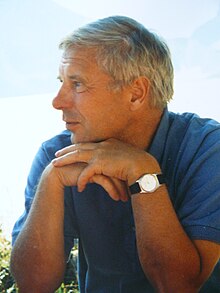Peter Dimroth
Peter Dimroth (born November 13, 1940 in Göttingen ) is a German chemist and biochemist .
Life
Peter Dimroth was born as the son of the chemist and university professor Karl Dimroth and his wife Lotte (née Grussdorf). He is married to the German artist and author Sinda Dimroth and has one son.
Peter Dimroth studied chemistry at the Universities of Marburg , Freiburg and Munich from 1960 to 1965. In 1969 he received his doctorate for his work at the Max Planck Institute for Cell Chemistry in Munich (today MPI for Biochemistry) under the direction of Feodor Lynen . From 1969 to 1971 Peter Dimroth was a postdoc at New York University , New York City and Johns Hopkins University , Baltimore. After returning to Germany in 1971, he was group leader at the University of Regensburg for the next eight years . From 1980 to 1990 Peter Dimroth worked as professor for physiological chemistry at the Technical University of Munich . In 1990 he was finally appointed professor of microbiology at the ETH Zurich , where he researched and taught until his retirement in 2005.
Act
Peter Dimroth's research was mainly aimed at a biochemical understanding of the metabolism and bioenergetics of bacteria . Peter Dimroth made the groundbreaking discovery that sodium ions take over the function of protons in certain membrane-embedded, ion-transporting enzyme complexes. In the course of his research, Peter Dimroth did pioneering work in the functional and structural characterization of ion-transporting enzyme complexes, which build up an electrochemical sodium ion potential or use it for the synthesis of ATP . He characterized the mechanism of a number of sodium-dependent enzyme complexes at the molecular level. These include decarboxylases , FoF1 ATP synthases and NADH: ubiquinone oxidoreductases . Overall, Peter Dimroth's research has defined the process of "decarboxylation phosphorylation", which, in addition to oxidative phosphorylation and substrate chain phosphorylation , has found its way into the textbooks of microbiology as the third form of ATP synthesis. Peter Dimroth's studies were of far-reaching importance for the fundamental process of biological "energy conservation", as they validated and expanded the concept of chemiosmotic ATP synthesis , which was originally established by Peter D. Mitchell and was awarded the Nobel Prize for Chemistry in 1978 .
Peter Dimroth's research work has been published in over 200 scientific articles. He was awarded the Karl Winnacker Prize in 1977 for his work, and he was regularly one of the most cited German microbiologists. In addition to his research achievements, Peter Dimroth was a committed university professor. Of his nearly 40 doctoral students and postdocs, some have embarked on careers as academic researchers and teachers.
Individual evidence
- ^ W. Hilpert, P. Dimroth: Conversion of the chemical energy of methylmalonyl-CoA decarboxylation into a Na + gradient . In: Nature . tape 296 , no. 5857 , April 8, 1982, pp. 584-585 , PMID 7070502 .
- ^ W. Hilpert, B. Schink, P. Dimroth: Life by a new decarboxylation-dependent energy conservation mechanism with Na as coupling ion . In: The EMBO journal . tape 3 , no. 8 , August 1, 1984, pp. 1665-1670 , PMID 16453537 .
- ↑ H. Hilbi, I. Dehning, B. Schink, P. Dimroth: Malonate decarboxylase of Malonomonas rubra, a novel type of biotin-containing acetyl enzyme . In: European Journal of Biochemistry / FEBS . tape 207 , no. 1 , July 1, 1992, p. 117-123 , PMID 1628643 .
- ^ W. Laubinger, P. Dimroth: Characterization of the Na + -stimulated ATPase of Propionigenium modestum as an enzyme of the F1F0 type . In: European Journal of Biochemistry / FEBS . tape 168 , no. 2 , October 15, 1987, p. 475-480 , PMID 2889596 .
- ^ W. Laubinger, P. Dimroth: Characterization of the ATP synthase of Propionigenium modestum as a primary sodium pump . In: Biochemistry . tape 27 , no. 19 , September 20, 1988, pp. 7531-7537 , PMID 2905167 .
- ↑ Christoph von Ballmoos, Josef Brunner, Peter Dimroth: The ion channel of F-ATP synthase is the target of toxic organotin compounds . In: Proceedings of the National Academy of Sciences . tape 101 , no. 31 , August 3, 2004, p. 11239-11244 , doi : 10.1073 / pnas.0402869101 , PMID 15277681 .
- ↑ Thomas Meier, Patrick Polzer, Kay Diederichs, Wolfram Welte, Peter Dimroth: Structure of the rotor ring of F-Type Na + -ATPase from Ilyobacter tartaricus . In: Science . tape 308 , no. 5722 , April 29, 2005, p. 659-662 , doi : 10.1126 / science.1111199 , PMID 15860619 .
- ^ XD Pfenninger-Li, SP Albracht, R. van Belzen, P. Dimroth: NADH: ubiquinone oxidoreductase of Vibrio alginolyticus: purification, properties, and reconstitution of the Na + pump . In: Biochemistry . tape 35 , no. 20 , May 21, 1996, pp. 6233-6242 , doi : 10.1021 / bi953032l , PMID 8639563 .
- ↑ Peter Dimroth, Christoph von Ballmoos: ATP synthesis by decarboxylation phosphorylation . In: Results and Problems in Cell Differentiation . tape 45 , January 1, 2008, p. 153-184 , doi : 10.1007 / 400_2007_045 , PMID 18049805 .
- ↑ Christoph von Ballmoos, Alexander Wiedenmann, Peter Dimroth: Essentials for ATP synthesis by F1F0 ATP synthases . In: Annual Review of Biochemistry . tape 78 , January 1, 2009, p. 649-672 , doi : 10.1146 / annurev.biochem.78.081307.104803 , PMID 19489730 .
Web links
- Publication comparison 1997-99: Microbiologists in the laboratory journal online
- Akademie Berlingen - lecture cycles from 1993 to today
- Peter Dimroth's patents
| personal data | |
|---|---|
| SURNAME | Dimroth, Peter |
| BRIEF DESCRIPTION | German chemist and biochemist |
| DATE OF BIRTH | November 13, 1940 |
| PLACE OF BIRTH | Goettingen |
